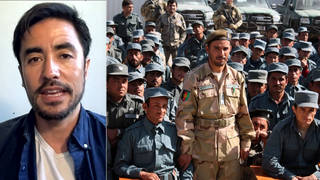
Topics
Guests
- Phyllis Bennisauthor and foreign policy scholar who directs the New Internationalism Project at the Institute for Policy Studies.
- Ro KhannaDemocratic congressmember from California.
The Taliban have continued to seize territory in Afghanistan as the U.S. completes its withdrawal of ground troops from the country, with the militant group now controlling a majority of Afghanistan’s districts and a quarter of provincial capitals. The strength of the Taliban offensive in recent weeks has put the future of Afghanistan’s government in doubt. “This kind of a crisis was inevitable whenever the U.S. pulled out, whether it had been 10 years ago, 19 years ago or 10 years from now,” says foreign policy scholar Phyllis Bennis, a fellow at the Institute for Policy Studies. “This was rooted in the nature of the U.S. occupation that began in 2001.” Congressmember Ro Khanna calls American involvement in Afghanistan a “fool’s errand” that should have ended years earlier.
Transcript
AMY GOODMAN: This is Democracy Now! I’m Amy Goodman, with Juan González.
The Taliban has captured three more provincial capitals. Nine of Afghanistan’s 34 provincial capitals are now under Taliban control, following a sweeping offensive. Earlier today, Afghanistan’s acting finance minister resigned and fled the country, after the Taliban captured key customs posts, stripping the government of a critical source of revenue. The Taliban now controls most of Afghanistan’s borders with Tajikistan and Uzbekistan in the north. This all comes as the United States is withdrawing troops after nearly 20 years of the longest U.S. war, the War in Afghanistan.
On Tuesday, the U.N. Office of the High Commissioner for Human Rights called for an end to urban fighting.
RAVINA SHAMDASANI: Civilian casualties are continuing to mount, and reports of violations that may amount to war crimes and crimes against humanity continue to emerge. We all know that urban warfare results in scores of civilians being killed. We have seen it before too many times. In Afghanistan, since the 9th of July, in four cities alone — and these are Lashkar Gah, Kandahar, Herat and Kunduz — at least 183 civilians have been killed, and 1,181 have been injured, including children.
AMY GOODMAN: Still with us, Congressmember Ro Khanna of California, and we’re joined by Phyllis Bennis, a fellow at the Institute for Policy Studies.
Phyllis, let’s begin with you. One provincial capital after another is in Taliban control. Can you talk about the significance of this?
PHYLLIS BENNIS: You know, Amy, I think it’s important that we recognize that this kind of a crisis was inevitable whenever the U.S. pulled out, whether it had been 10 years ago, 19 years ago or 10 years from now, the reason being that this was rooted in the nature of the U.S. occupation that began in 2001. There was not at that time — there is now not — a military solution to terrorism, which was ostensibly the reason for the invasion and occupation of Afghanistan. There is no military solution to the, quote, “problems of Afghanistan.”
And the notion that the U.S. could create a military force in Afghanistan that was going to be prepared to defend the country against an indigenous opposition force, the Taliban, was never going to be possible, because it was based on the idea that this would be a military that was supporting a government shaped and imposed by the United States in a Western model that had no bearing on the reality of politics and culture in Afghanistan, specifically the question of imposing a nationally based government with power centralized in the capital — something that was completely opposite of the long-standing, eons-long culture and history of Afghanistan, that was always based on local and tribal and family and clan-based power rather than national power. It was never going to work.
The New York Times this morning said that the current events show how little control the Afghan government has without the U.S. military’s support. The reality is, it shows how little power the Afghan military has without popular support, which it never had. That’s the reason that it has failed to support the country, it has failed to fight back in most of these situations. I think the count is something like six out of the nine, maybe more. There was virtually no fighting back by the Afghan military forces. This is a force ostensibly made up of 300,000 troops trained and armed by the United States for 20 years. The issue isn’t that Afghans don’t know how to fight. Afghanistan has not been called the “graveyard of empires” for nothing. Afghans can be very good fighters when they are fighting for something they believe in. It’s clear that this military, in support of a government characterized, more than anything else, by corruption and incompetence, as well as dependency on the United States, simply had no will to fight.
So, what we don’t know for sure is what the final result will be, whether this will result in a full — a level of full Taliban control over the country or whether there will still be some kind of power-sharing arrangement. Either way, the Taliban are clearly going to have significant influence, significant power in Afghanistan. The key situation, the key challenge right now, of course, is the civilian casualties and the displacement of thousands and thousands of people, many of them crowding into Kabul, which is not yet capable of providing even the basics of water and shelter for the many people, the many families, including many, many children, that are flooding into the city. So this is going to be a huge challenge for everyone in power, in every place in Afghanistan, including the government, and certainly including the Taliban as they take power in some of these cities.
JUAN GONZÁLEZ: Yeah, well, I’d like to ask Congressmember Ro Khanna this: Where is the outrage in Congress over not only the loss of lives over the last 20 years, but the extraordinary cost of these wars in Afghanistan and Iraq? We’re talking about $2 trillion, that was all financed by debt. I think we’re going to have spent $2 trillion just in interest payment on the debt of these wars, and that’s not counting another $2 trillion that’s expected in benefits to veterans of these wars over the coming decades. An enormous amount of money thrown down and wasted, essentially, where we are right now, in what is really this generation’s Vietnam.
REP. RO KHANNA: It has been a colossal waste of resources, $6 trillion when you combine both the Afghanistan and Iraq War, and an enormously tragic loss of American lives and civilian lives. I supported the initial strikes into Afghanistan to go after al-Qaeda. Al-Qaeda perpetrated the 9/11 attacks. And we achieved that mission within six to seven months. But it morphed then into a mission to try to deny the Taliban control over Afghanistan. And that was a fool’s errand. Well before President Biden’s courageous decision to finally end the war, the Taliban was already controlling a large part of the territory, almost 70%. Even when we had the escalation of troops into Afghanistan, the surge into Afghanistan, the Taliban continued to win. So, this idea that American military force was going to deprive the Taliban of control was just wrong.
What do we do now? The president has sent a special envoy to the region. We need to do whatever we can with the international community and the regional community there to seek a ceasefire, to seek peace, to do what we can to uphold human rights, recognizing that the Taliban does violate human rights. But we have to do the best we can in the circumstances, and we need to do the best we can for the civilians, including making sure that we are taking our share of asylum seekers from the area and that we’re doing what we can to provide water and basic necessities to the civilians through the international organizations.
JUAN GONZÁLEZ: And, Phyllis, Phyllis Bennis, what’s your sense? Are we likely to see, in the coming weeks and months, scenes like we saw in Vietnam? As the U.S. troops are leaving, the Taliban are marching into Kabul, the capital?
PHYLLIS BENNIS: I don’t think we know that yet. In the past, the Taliban have indicated some reticence to try to take the capital. They know what the consequences could look like. The U.S. concerns, for many years, has been that of Vietnam, as you say, Juan, the notion of creating a, quote, “decent interval” between the time that U.S. troops pull out and the time that the opposition forces consolidate their power over the whole country. That interval is likely to be very short in Afghanistan.
What we do have to recognize is that the U.S., while pulling out the ground troops, is continuing right now, and is indicating further continuation, of airstrikes and drone strikes. Those are continuing to kill civilians. And that’s a significant problem, as well as the continuing presence of CIA forces throughout the country. There have been significant reports in the last year from Human Rights Watch and The Intercept and others indicating massive training by the CIA of death squads in Afghanistan that have been responsible for attacks on schools, on villages, on children as young as 8 years old. And those death squads, as far as we know, are continuing. They have no — there’s no indication that they have stopped. There’s no indication that CIA officials that have been training those death squads are being pulled out as the ground troops are pulled out. So, the question of continuing U.S. responsibility for the violence in Afghanistan plaguing ordinary Afghan civilians is still very serious.
There is the possibility for negotiations with the Taliban, no question about that. We know that in the past, negotiations have gone on between Taliban officials and local religious and tribal officials over issues of education, healthcare, other social questions, and they’ve been able to be resolved in a relatively amicable way. The notion that the lives of Afghan women are suddenly going to get better, of course that’s not the case. But we have to be very clear that while the Taliban represent a very extreme and misogynist and violent definition of religious law, the government and its supporters in Afghanistan have been very close to that level of misogyny and violence towards the civilian population.
Right now the forces fighting on the part of the government side include a number of warlord-led militias that are reconstituting, including some of those — for example, the militia led by Marshal Abdul Rashid Dostum, who was an Uzbek member of Afghanistan’s ruling forces at the time that the U.S. took over, whose militia was responsible for one of the biggest massacres, one of the biggest human rights violations, a crime against humanity, a war crime, in the first months after the U.S. occupation began, when they captured somewhere between 250 and 2,000 Taliban prisoners, who were then killed by being suffocated in shipping containers. That Afghan militia is now being reconstituted and is fighting on the side of the U.S.-backed government. So, the notion that somehow the gap between the bad guy, Taliban, and the good guy, government, is a very wide gap is simply not the case.
AMY GOODMAN: In fact, Phyllis —
PHYLLIS BENNIS: There’s a very —
AMY GOODMAN: — President Ghani just held crisis talks in Mazar-i-Sharif, where you’re describing the warlord, Abdul Rashid Dostum, engaged in that massacre, and also he met with prominent ethnic Tajik leader Atta Muhammad Nur about defending Mazar. I wanted to play a clip of President Biden.
REPORTER: In just the last few days, multiple cities in Afghanistan have fallen to the Taliban. There is irrefutable evidence that a vast majority of those Afghan forces cannot hold ground there. Has your current plan to withdraw U.S. troops changed at all?
PRESIDENT JOE BIDEN: No. Look, we spent over a trillion dollars over 20 years. We trained and equipped with modern equipment over 300,000 Afghan forces. And Afghan leaders have to come together. We lost thousands — lost in death and injury — thousands of American personnel. They’ve got to fight for themselves, fight for their nation.
AMY GOODMAN: “Fight for their nation.” Congressmember Ro Khanna, the U.S. is pulling out of Afghanistan, but actually leaving thousands. I mean, there are going to be mercenaries there. There’s going to be entire — intelligence, CIA operatives. Phyllis talked about the setting up — them helping to set up death squads. What is, should be the U.S. role after?
REP. RO KHANNA: Well, first of all, I give President Biden credit for pulling out our troops. He had to overrule, as I’ve read in the papers, the advice of his own generals. He is a president who has had the courage to end this war, when many previous presidents have not.
I believe it shows us that we can’t intervene in a civil war. The Taliban, no doubt, are brutal actors who have no regard for women and human rights. I don’t think we should sugarcoat that. They have committed extraordinary atrocities and disproportionate atrocities. I don’t think there is a moral equivalence between the Taliban and the current Afghan government. But as the other guest has suggested, the Afghan government hasn’t had clean hands. They have committed atrocities, as well. And there’s simply nothing —
AMY GOODMAN: We have five seconds.
REP. RO KHANNA: — nothing to be gained by the U.S. intervention and involvement there.
AMY GOODMAN: We want to thank you, California Congressmember Ro Khanna and Phyllis Bennis, fellow at the Institute for Policy Studies, certainly something we will continue to cover. I’m Amy Goodman, with Juan González. Wear a mask. Stay safe.













Media Options